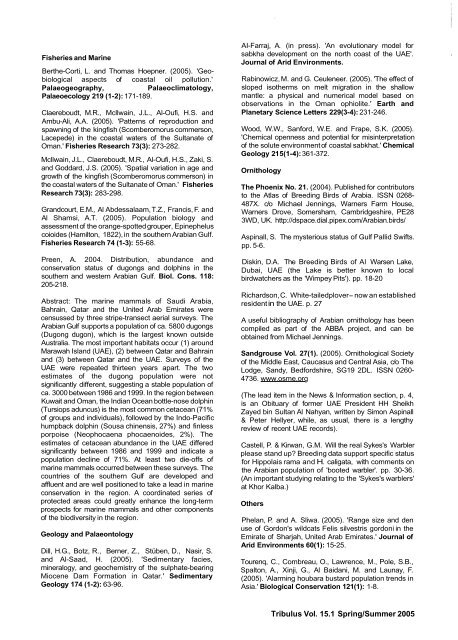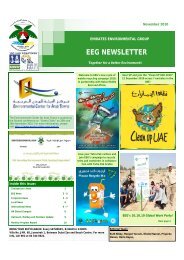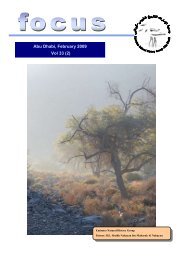Oman (Lepidoptera: Pieridae) - Al Ain Chapter, Emirates Natural ...
Oman (Lepidoptera: Pieridae) - Al Ain Chapter, Emirates Natural ...
Oman (Lepidoptera: Pieridae) - Al Ain Chapter, Emirates Natural ...
You also want an ePaper? Increase the reach of your titles
YUMPU automatically turns print PDFs into web optimized ePapers that Google loves.
Fisheries and Marine<br />
Berthe-Corti, L. and Thomas Hoepner. (2005). 'Geo-<br />
biological aspects of coastal oil pollution.'<br />
Palaeogeography, Palaeoclimatology,<br />
Palaeoecology 21 9 (1-2): 171 -1 89.<br />
Claereboudt, M.R., Mcllwain, J.L., <strong>Al</strong>-Oufi, H.S. and<br />
Ambu-<strong>Al</strong>i, A.A. (2005). 'Patterns of reproduction and<br />
spawning of the kingfish (Scomberomorus commerson,<br />
Lacepede) in the coastal waters of the Sultanate of<br />
<strong>Oman</strong>.' Fisheries Research 73(3): 273-282.<br />
Mcllwain, J.L., Claereboudt, M.R., <strong>Al</strong>-Oufi, H.S., Zaki, S.<br />
and Goddard, J.S. (2005). 'Spatial variation in age and<br />
growth of the kingfish (Scomberomorus commerson) in<br />
the coastal waters of the Sultanate of <strong>Oman</strong>.' Fisheries<br />
Research 73(3): 283-298.<br />
Grandcourt, E.M., <strong>Al</strong> Abdessalaam, T.Z., Francis, F. and<br />
<strong>Al</strong> Shamsi, A.T. (2005). Population biology and<br />
assessment of the orange-spotted grouper, Epinephelus<br />
coioides (Hamilton, 1822), in the southern Arabian Gulf.<br />
Fisheries Research 74 (1-3): 55-68.<br />
Preen, A. 2004. Distribution, abundance and<br />
conservation status of dugongs and dolphins in the<br />
southern and western Arabian Gulf. Biol. Cons. 118:<br />
205-21 8.<br />
Abstract: The marine mammals of Saudi Arabia,<br />
Bahrain, Qatar and the United Arab <strong>Emirates</strong> were<br />
censussed by three stripe-transect aerial surveys. The<br />
Arabian Gulf supports a population of ca. 5800 dugongs<br />
(Dugong dugon), which is the largest known outside<br />
Australia. The most important habitats occur (1) around<br />
Marawah Island (UAE), (2) between Qatar and Bahrain<br />
and (3) between Qatar and the UAE. Surveys of the<br />
UAE were repeated thirteen years apart. The two<br />
estimates of the dugong population were not<br />
significantly different, suggesting a stable population of<br />
ca. 3000 between 1986 and 1999. In the region between<br />
Kuwait and <strong>Oman</strong>, the Indian Ocean bottle-nose dolphin<br />
(Tursiops aduncus) is the most common cetacean (71 %<br />
of groups and individuals), followed by the Indo-Pacific<br />
humpback dolphin (Sousa chinensis, 27%) and finless<br />
porpoise (Neophocaena phocaenoides, 2%). The<br />
estimates of cetacean abundance in the UAE differed<br />
significantly between 1986 and 1999 and indicate a<br />
population decline of 71%. At least two die-offs of<br />
marine mammals occurred between these surveys. The<br />
countries of the southern Gulf are developed and<br />
affluent and are well positioned to take a lead in marine<br />
conservation in the region. A coordinated series of<br />
protected areas could greatly enhance the long-term<br />
prospects for marine mammals and other components<br />
of the biodiversity in the region.<br />
Geology and Palaeontology<br />
Dill, H.G., Botz, R., Berner, Z., Stüben, D., Nasir, S.<br />
and <strong>Al</strong>-Saad, H. (2005). 'Sedimentary facies,<br />
mineralogy, and geochemistry of the sulphate-bearing<br />
Miocene Dam Formation in Qatar.' Sedimentary<br />
Geology 174 (1-2): 63-96.<br />
AI-Farraj, A. (in press). 'An evolutionary model for<br />
sabkha development on the north coast of the UAE'.<br />
Journal of Arid Environments.<br />
Rabinowicz, M. and G. Ceuleneer. (2005). 'The effect of<br />
sloped isotherms on melt migration in the shallow<br />
mantle: a physical and numerical model based on<br />
observations in the <strong>Oman</strong> ophiolite.' Earth and<br />
Planetary Science Letters 229(3-4): 231 -246.<br />
Wood, W.W., Sanford, W.E. and Frape, S.K. (2005).<br />
'Chemical openness and potential for misinterpretation<br />
of the solute environment of coastal sabkhat.' Chemical<br />
Geology 21 5(1-4): 361 -372.<br />
Ornithology<br />
The Phoenix No. 21. (2004). Published for contributors<br />
to the Atlas of Breeding Birds of Arabia. ISSN 0268-<br />
487X. c/o Michael Jennings, Warners Farm House,<br />
Warners Drove, Somersham, Cambridgeshire, PE28<br />
3WD, UK. http://dspace.dial.pipex.com/Arabian.birds/<br />
Aspinall, S. The mysterious status of Gulf Pallid Swifts.<br />
pp. 5-6.<br />
Diskin, D.A. The Breeding Birds of <strong>Al</strong> Warsen Lake,<br />
Dubai, UAE (the Lake is better known to local<br />
birdwatchers as the 'Wimpey Pits'). pp. 18-20<br />
Richardson, C. White-tailedplover - now an established<br />
resident in the UAE. p. 27<br />
A useful bibliography of Arabian ornithology has been<br />
compiled as part of the ABBA project, and can be<br />
obtained from Michael Jennings.<br />
Sandgrouse Vol. 27(1). (2005). Ornithological Society<br />
of the Middle East, Caucasus and Central Asia, c/o The<br />
Lodge, Sandy, Bedfordshire, SG19 2DL. ISSN 0260-<br />
4736. www.osme.org<br />
(The lead item in the News & Information section, p. 4,<br />
is an Obituary of former UAE President HH Sheikh<br />
Zayed bin Sultan <strong>Al</strong> Nahyan, written by Simon Aspinall<br />
& Peter Hellyer, while, as usual, there is a lengthy<br />
review of recent UAE records).<br />
Castell, P. & Kirwan, G.M. Will the real Sykes's Warbler<br />
please stand up? Breeding data support specific status<br />
for Hippolais rama and H. caligata, with comments on<br />
the Arabian population of 'booted warbler'. pp. 30-36.<br />
(An important studying relating to the 'Sykes's warblers'<br />
at Khor Kalba.)<br />
Others<br />
Phelan, P. and A. Sliwa. (2005). 'Range size and den<br />
use of Gordon's wildcats Felis silvestris gordoni in the<br />
Emirate of Sharjah, United Arab <strong>Emirates</strong>.' Journal of<br />
Arid Environments 60(1): 15-25.<br />
Tourenq, C., Combreau, O., Lawrence, M., Pole, S.B.,<br />
Spalton, A., Xinji, G., <strong>Al</strong> Baidani, M. and Launay, F.<br />
(2005). '<strong>Al</strong>arming houbara bustard population trends in<br />
Asia.' Biological Conservation 121 (1): 1-8.<br />
Tribulus Vol. 15.1 Spring/Summer 2005




